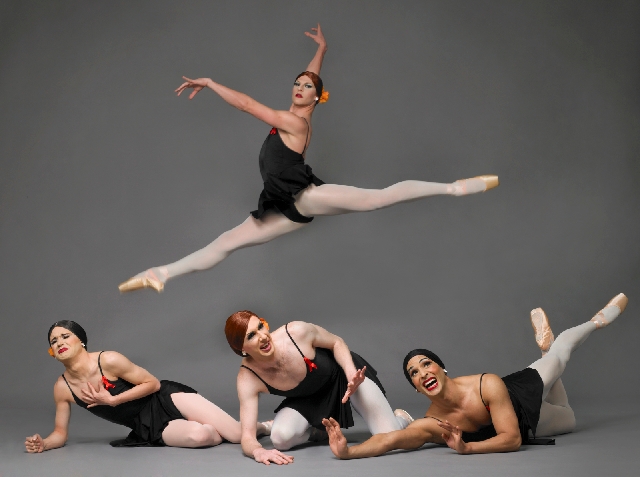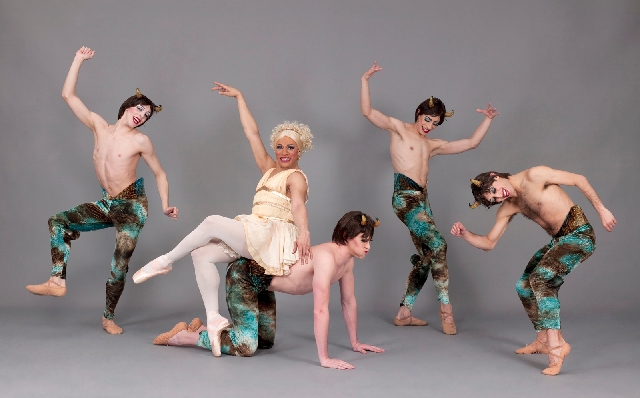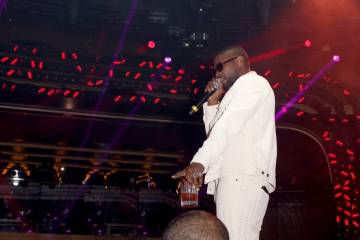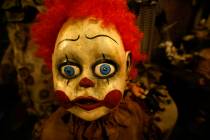Troupe dances in drag, mixing comedy, ballet at Smith Center
Come for the comedy, stay for the ballet. Or come for the ballet and stay for the comedy.
Now you’re Trockin’.
More formally, you’re experiencing Les Ballets Trockadero de Monte Carlo.
The celebrated dance-in-drag troupe makes its Smith Center for the Performing Arts debut Tuesday with a typically eclectic program that spoofs ballet legends from Balanchine to the Bolshoi.
It’s hardly the Trock’s first Vegas visit; the company previously performed at the University of Nevada, Las Vegas.
Along with a new venue, however, the dancers will perform “a completely new program,” artistic director Tory Dobrin says in a telephone interview.
It’s a new program, but one that sticks with the philosophy the Trock has followed for almost four decades.
Since its 1974 founding, the Trock has been “an all-male comedy ballet,” Dobrin says.
Each of those words “is very important,” he adds. “It’s a comedy company and a ballet company. We use drag as a vehicle for comedy.”
The laughs begin when you check out the Trock’s roster of performers, who sport such pun-tastic noms de pointe as Ida Nevasayneva and Velour Pilleaux (both of whom are really dancer Paul Ghiselin ) or Maya Thickenthighya and Mikhail Mypansarov (alias Carlos Miller).
Dobrin spent almost two decades dancing at the Trock as Margaret Lowin-Octeyn (a name suspiciously reminiscent of Royal Ballet legend Margot Fonteyn ).
“When I joined, it was considered a career-wrecker,” Dobrin says of the Trock. “Now it’s considered a career choice.”
Those who choose to join the Trock (started by ballet enthusiasts who wanted to present playful proof that men could dance en pointe, without falling flat on their faces) represent “a particular kind of guy,” Dobrin says. “They’re funny guys. Otherwise they wouldn’t want to do this.”
They’re also dancers “interested in the pointe work,” he adds. “Who knows why — it’s better not to analyze.”
For whatever reason(s), they’re eager to embrace the trappings of traditional ballet, from spangly tutus to pink toe shoes, for comedic as well as aesthetic effect.
In the process, the dancers “are having as much fun as the audience,” Dobrin points out. “Usually, ballet is so serious. And we’re not.”
Leading off Tuesday’s performance: “Chopeniana ,” danced to music by (you guessed it) Frederic Chopin. It’s “an ‘abstract’ classical ballet, without narrative structure or defined characters” that “atmospherically suggests ‘Giselle’ and ‘La Sylphide,’ ” according to the program notes.
An as-yet-undetermined pas de deux (“probably ‘Don Quixote,’ ” Dobrin says) will kick off Act II, followed by “Go For Barocco .”
Danced to a Bach score, “Barocco” emerges as the Trock’s spoofy salute to “Balanchine’s Middle-Blue-Verging-On-Black-and-White-Period,” as the program notes explain, “a wristwatch for Balanchine clock-time.”
Also on the program: the Trock’s signature piece “Dying Swan,” plus “Walpurgis Night,” a takeoff on a Bolshoi Ballet favorite that “Russians have long respected as a specimen of Soviet balletic camp,” according to the program notes.
There’s a direct connection between the Bolshoi and the Trock: Elena Kunikova , who staged the Trock version “just like they did it when she danced it in Russia,” Dobrin says. “Except that they had 80 dancers and we have 16.”
After the Trock dancers have mastered the ballet’s steps, “guys start relaxing, they start having fun in rehearsal,” he adds, “and the innate comedy comes out.”
That comedy remains a focal point for the Trock’s dancers, Dobrin says.
“We always remember that the audience is coming to enjoy themselves,” he says, “and to see great dancing.”
Some of that dancing occurs in works “people wouldn’t necessarily have a chance to see otherwise,” Dobrin points out, citing “Walpurgis Night” as an example of Soviet-era “ballets that are not seen in the West” very often.
In the same vein, a Trock performance can serve as “a really wonderful introduction to ballet” — for audiences of all ages.
When Dobrin joined the company in 1980, he recalls, “there were absolutely no children in the audience.”
In part, perhaps, because “drag and comedy and ballet” were still an “unusual” combination, Dobrin muses.
But “after Madonna and RuPaul” and such movies as “Tootsie” and “Mrs. Doubtfire,” plus Broadway musicals from “La Cage aux Folles” to the newly opened “Kinky Boots” (with a score by Cyndi Lauper), about a drag queen who saves a British shoe factory, “drag is not what it was then, in 1974,” Dobrin says. “Society’s changed.”
But, in essence, the Trock hasn’t — and that’s precisely the point. Whether you love ballet or hate ballet, the Trock promises “a fun night,” he says. After all, “everyone likes to be in the midst of a party.”
Contact reporter Carol Cling at ccling@
reviewjournal.com or 702-383-0272.
Preview
Les Ballets Trockadero de Monte Carlo
7:30 p.m. Tuesday, April 23
Reynolds Hall, The Smith Center for the Performing Arts, 361 Symphony Park Ave.
$26-$79 (702-749-2000, www.thesmithcenter.com)























